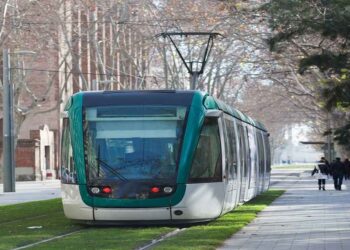Network Rail electrify the two important milestones as announces section of the line to be energised for the first time, its flagship ETC in Swindon is officially opened.
As part of Network Rail’s Railway Upgrade Plan to provide a bigger, better, more reliable railway for passengers, the company is electrifying the Great Western Main Line in preparation for the arrival of a new fleet of longer, faster, quieter and greener electric trains.
The section of the main line that runs between Reading and Didcot now has the majority of the overhead line equipment installed, including the wires that carry the high voltage electricity to power the electric trains. Once complete, this section of track will be used to test the new electric trains.
Reaching this important milestone means members of the public should treat all overhead line equipment, whether it looks complete or not, as electrified. To make sure everyone is prepared for this change, Network Rail is carrying out a safety awareness programme that over the last few months has included extensive engagement activities at community events, schools and colleges.
Mark Langman, Network Rail’s managing director for the Western route, said: “This marks a really important milestone in our work to upgrade Brunel’s railway. For the first time a major section of the Great Western Main Line will soon have a fully functioning overhead power supply, enabling us to start testing the new electric trains.
“As safety is our highest priority, it’s very important the public know how to keep themselves and others safe around this new equipment which is why we are carrying out an extensive awareness campaign.â€The news came at the opening of the £10m state-of-the-art Electrification Training Centre in Swindon, which features the overhead line equipment, in every configuration, on a section of track not connected to the main line. This enables Network Rail’s engineering ‘orange army’ to learn how to install and maintain the new system in a safe environment.
The opening of the centre coincides with Swindon celebrating its 175th anniversary as a railway town and it is anticipated it will become a regional centre of excellence, training large numbers of railway apprentices and technicians from across the Thames Valley, west, south west and Wales.
Mark continued: “Swindon has a proud railway heritage and so it seems very fitting that in celebrating its 175thanniversary as a railway town this state-of-the-art centre has opened. This centre will train our future railway engineers, ensuring Swindon remains at the heart of the Great Western Railway for generations to come.
“The opening of the Electrification Training Centre, together with the completion of a major part of our electrification programme means communities in the Thames Valley, south west and west are a step closer to the benefits that electrification will bring. These include faster trains with more seats and more legroom, and less noise and cleaner air for those who live close to the railway.â€Justin Tomlinson, MP for North Swindon, said: “I was very excited to attend the opening of the Electrification Training Centre. This opening will bring more jobs and will eventually mean greater connections to London and the south west.
“Swindon is a town on the up which continues to expand and attract more investment. This centre is a crucial part of our growth and what better way to mark 175 years of the Great Western Railway.â€
Robert Buckland QC, MP for South Swindon, said: “With its proud railway past, Swindon was the obvious choice for the headquarters of this huge scheme and I am delighted to have been at the opening of the Electrification Training Centre.“I worked hard to campaign for the electrification of the Great Western Main Line, which will transform the railway and provide Britain with a sustainable, world-class transport system.“The project to electrify the Great Western Main Line is one obvious example of increasing investment in Swindon. In effect, our town is the nerve centre of the project, and also houses all of the material and equipment. “
About the Great Western Electrification Programme
Electrification will transform the railway between London and Oxford, Newbury, Bristol and Cardiff to deliver a faster, greener, quieter and more reliable railway for passengers, with extra capacity. Electrifying this part of the Great Western route will enhance 235 miles of one of Britain’s busiest and oldest railways, better connecting major towns and cities across southern England and South Wales. This investment, as well as the introduction of a fleet of new trains, will improve journey times and make services more comfortable, smoother, cleaner and quieter for passengers and people living near the railway.
Victoria Bradley
Media relations manager (Western route)
Network Rail
01793 389749 / 07710 938470
victoria.bradley@networkrail.co.uk
About Network Rail
Network Rail owns, manages and develops Britain’s railway – the 20,000 miles of track, 40,000 bridges and viaducts and the thousands of signals, level crossings and stations (the largest of which we also run). In partnership with train operators we help people take more than 1.65bn journeys by rail every year and move hundreds of millions of tonnes of freight, saving almost 8m lorry journeys. We employ 36,000 people across Britain and work round-the-clock, each and every day, to provide a safe, reliable railway.
About the Railway Upgrade Plan
The Railway Upgrade Plan is Network Rail’s investment plan for Britain’s railways. It makes up two-thirds of Network Rail’s £40bn spending priorities for the five years to 2019 and represents the biggest sustained programme of rail modernisation since the Victoria era. It is designed to provide more capacity, relieve crowding and respond to the tremendous growth Britain’s railways continue to experience; passenger numbers have doubled in the past 20 years and are set to double again over the next 25 years – so we need to continue to invest in building a bigger, better railway. For passengers, that means:
- • longer, faster more frequent trains;
- • better, more reliable infrastructure; and
- • better facilities for passengers, especially at stations.
Visit our online newsroom: www.networkrailmediacentre.co.uk
































